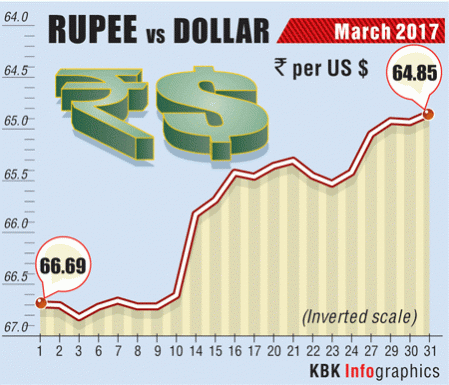
A slew of positive factors, mainly a spurt in debt and equity investments by foreign investors, enabled the Indian rupee to not only end up as the third best-performing Asian currency in the March quarter but also bring cheer to importers and outbound Indian travellers. On Friday, the rupee closed at 64.85/64.86 to the US dollar.
The domestic currency gained 4.63 percent, while the other two performing currencies were the Korean won (up almost 8 percent) and the Taiwan dollar (up 6.4 percent).
"The rupee has been the third best-performing Asian currencies this year, surging nearly 4.63 percent in the March quarter, its best quarterly gains since September 2012, on better domestic and global developments," IFA Global said in a note.
Reuters reported that the Korean won was poised to put "its best quarter since the third quarter of 2009" along with the Taiwan dollar on the back of a surge in foreign investors buying South Korean and Taiwanese stocks.
The strengthening of the Indian rupee is mainly due to the buoyancy in foreign investments. "...foreign inflows have surged on year-to-date basis. Portfolio inflows have surpassed $7.5 billion (equity and debt) more than reversing $ 3 billion outflows last year. As a result, the rupee is up 4.4 percent on year-to-date basis, amongst the better performers in the region," Radhika Rao, economist, group research at DBS Bank, had said in a note on Wednesday.
An appreciating rupee is good for India's imports as it reduces the landed cost of goods, apart from making outbound travel cheaper for Indians. India imports about 80 percent of its crude oil needs.
The union ministry of petroleum and natural gas' PPAC had estimated India's oil import bill for FY2017 at $70.71 billion (presuming an exchange rate of 67/1 dollar), down from $63.97 billion in FY2016.
For every increase or decrease of Re 1 to the US dollar, the import bill increases or decreases by Rs 721 crore ($0.11 billion), according to the PPAC.
On the flip side, exporters stand to lose as a result of an appreciating rupee since most of their earnings are in dollars.
India's foreign exchange reserves rose $1.15 billion to $367.93 billion as of March 24, 2017, up from $355.59 billion as of March 25, 2016.


















